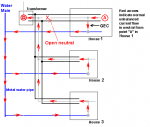synchro
Senior Member
- Location
- Chicago, IL
- Occupation
- EE
Most jumper cables have copper plated steel wires. If you want to use the jumper frequently I'd recommend using a length of welding cable because it's finely stranded and can be moved around on a regular basis without fracturing the stands.
There are some ground clamps for welding that should work OK in clamping to pipe. I would look around to see which is best for your needs and will be secure enough.
Another alternative is ground clamps made for pipe like this one:
 www.gordonelectricsupply.com
www.gordonelectricsupply.com
There are some ground clamps for welding that should work OK in clamping to pipe. I would look around to see which is best for your needs and will be secure enough.
Another alternative is ground clamps made for pipe like this one:
BURNDY C11HD-4/0-DB GRD CLAMP | Gordon Electric Supply, Inc.
BURNDY C11HD4/0DB GROUND CLAMP 1/2-1 DB 4/0 HUB


